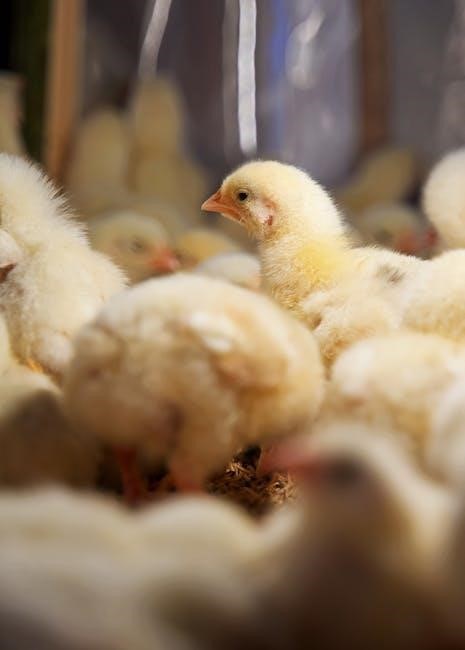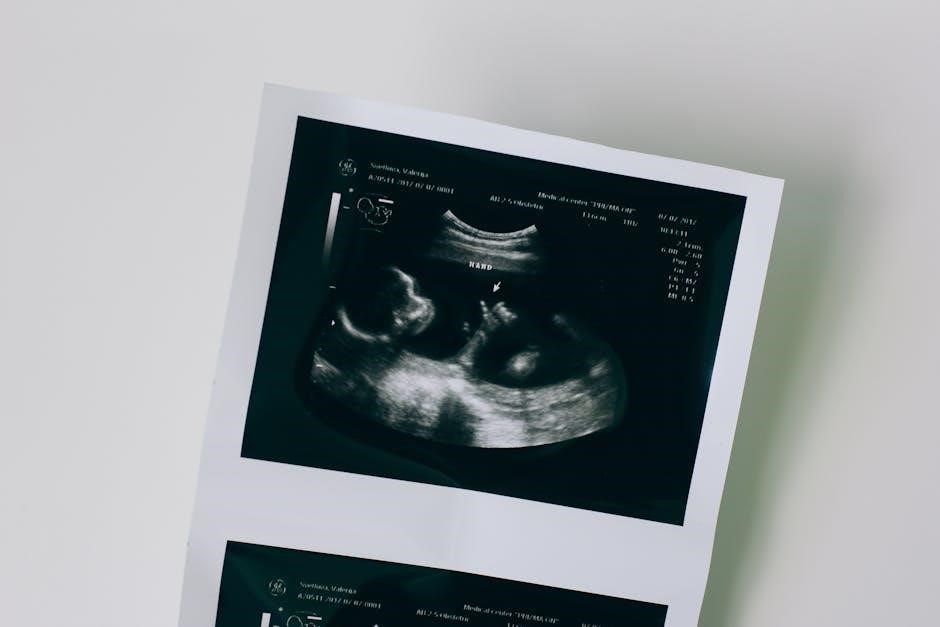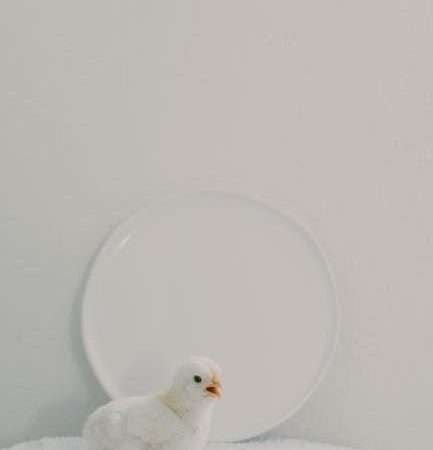Chick embryo development is a fascinating biological process, offering insights into vertebrate embryogenesis. Starting from fertilization, the embryo undergoes predictable stages, making it a model for developmental biology studies.
1.1 Overview of the Embryonic Development Process
The chick embryo development process begins with fertilization, followed by blastoderm formation and critical events like gastrulation and neurulation. The embryo progresses through predictable stages, including organogenesis and the formation of extra-embryonic membranes. Development is divided into incubation phases, with key milestones such as appendage formation, feather development, and hatching. This process is well-documented, making it a valuable model for studying vertebrate embryogenesis and developmental biology.
1.2 Importance of Studying Chick Embryo Development

Studying chick embryo development provides valuable insights into vertebrate morphogenesis and genetics. The accessibility of embryos at all stages makes them an excellent model for research. Chick embryos are widely used in developmental biology to study tissue formation, organogenesis, and gene expression. They also serve as a cost-effective and ethical alternative for testing developmental hypotheses. This knowledge contributes to advancements in fields like regenerative medicine, evolutionary biology, and agricultural sciences, enhancing our understanding of life’s fundamental processes.

Early Developmental Stages of the Chick Embryo

Chick embryo development begins with fertilization, forming the blastoderm, which undergoes cleavage and morphological changes. Early stages include blastula formation and gastrulation, laying the foundation for organ development.
2.1 Fertilization and Blastoderm Formation
Fertilization initiates chick embryo development, forming a zygote that undergoes cleavage. The blastoderm, a dense layer of cells, appears as the embryo progresses. This stage is critical, as it establishes the foundation for future growth. The blastoderm evolves into the gastrula, marking the onset of germ layer formation. These early processes are essential for organizing the body plan and determining the embryo’s structural development.
2.2 Gastrulation and the Formation of the Primitive Streak
Gastrulation is a pivotal stage where the blastoderm transforms into a trilaminar embryo. The primitive streak forms, initiating cell migration and differentiation. This process establishes the germ layers: ectoderm, mesoderm, and endoderm. The streak’s development is crucial for axial patterning and organogenesis. Proper gastrulation ensures the formation of vital structures, making it a cornerstone of embryonic development.

Key Milestones in Chick Embryo Development
Key milestones include neural plate formation, head fold development, and appendage growth. These stages mark critical transitions, shaping the embryo’s structure and functionality.

3.1 Formation of the Neural Plate and Head Fold
The neural plate forms from the ectoderm, marking the beginning of the central nervous system. Around days 3-4, the head fold emerges, bending the embryo forward. This folding brings the head toward the heart, establishing the cranial structure. The neural plate thickens, forming the neural groove, which later closes to create the neural tube. These processes are vital for brain and spinal cord development, guided by precise cellular signaling and morphogenetic movements.
3.2 Development of Appendages and Visceral Arches
During chick embryo development, appendages like wings and legs begin to form as limb buds around days 4-6. These buds grow and differentiate into recognizable structures. Simultaneously, visceral arches develop, contributing to jaw, gill, and neck structures. Morphogenetic movements shape these formations, while genetic factors guide patterning. The coordination of these processes ensures proper skeletal and muscular development, laying the foundation for the chick’s physical features and functional movements after hatching.

The Hamburger-Hamilton Staging System
The Hamburger-Hamilton Staging System provides a standardized framework for categorizing chick embryo development. Developed by Viktor Hamburger and Howard Hamilton, it ensures consistent tracking of embryonic growth stages.
4.1 Overview of the Staging System
The Hamburger-Hamilton Staging System is a comprehensive framework for tracking chick embryo development, categorizing growth from fertilization to hatching into 46 distinct stages. Each stage is defined by specific morphological changes, providing a clear timeline for embryonic progression. This system, developed by Viktor Hamburger and Howard Hamilton, is widely used in embryology studies, offering a standardized reference for researchers and educators. It ensures consistency in documenting developmental milestones, facilitating comparative studies and experimental designs.
4.2 Critical Milestones in the HH Staging System
Key milestones in the Hamburger-Hamilton system include the appearance of the primitive streak (Stage 3), neural plate formation (Stage 4), and head and tail folding (Stage 7-8). Limb buds emerge around Stage 17, while feather germs appear by Stage 25. Eyelid closure occurs at Stage 28, and beak formation is evident by Stage 34. These milestones provide a precise timeline for tracking chick embryo development, aiding researchers and educators in understanding growth patterns and developmental biology principles.

Extra-Embryonic Membranes and Their Role
Extra-embryonic membranes, such as the amnion, chorion, and allantois, play crucial roles in supporting chick embryo development by providing protection, facilitating gas exchange, and managing waste and nutrients.
5.1 Development of the Amnion and Chorion
The amnion and chorion are critical extra-embryonic membranes in chick development. The amnion forms as a fold, enclosing the embryo in a protective fluid-filled cavity by day 3-4. The chorion develops from the blastoderm’s outer layer, contributing to gas exchange and nutrient uptake. Together, they ensure proper growth and development, with the amnion safeguarding the embryo and the chorion aiding in respiration and waste management, essential for the chick’s maturation.
5.2 Formation and Function of the Allantois
The allantois emerges as a vesicle from the embryo’s hindgut around day 4, expanding to store waste products like urea. It fuses with the chorion by day 6, forming the chorioallantoic membrane. This membrane facilitates gas exchange and calcium absorption from the eggshell. The allantois also plays a role in regulating fluid and ions, ensuring the embryo’s environment remains stable. By day 18, it is fully integrated into the yolk sac, supporting the chick’s final developmental stages before hatching.
The Hatching Process
The hatching process begins with internal pipping, where the embryo breaks into the air cell. The chick emerges by breaking through the shell using its egg tooth.
6.1 Internal and External Pipping

Internal pipping occurs when the embryo breaks into the air cell, initiating the hatching process. External pipping follows, where the chick starts breaking through the shell. The egg tooth facilitates this by creating a small hole. These stages are critical as the embryo transitions to a chick, marking the final steps before hatching. Proper conditions ensure successful pipping and emergence.
6.2 Transition from Embryo to Chick
The transition from embryo to chick involves the absorption of the yolk sac and the completion of organ development. By day 21, the embryo is fully formed, with feathers covering its body. The amniotic fluid decreases, and the head is positioned between the legs. The chick emerges from the shell, marking the end of embryonic development. This stage is crucial as the chick adapts to life outside the egg, transitioning into a fully functional, independent organism.

Observing and Documenting Developmental Stages
Techniques like microscopy and sectioning allow detailed observation of chick embryo development. Documenting through diagrams and labeled stages helps track progress and analyze developmental milestones accurately.
7.1 Techniques for Observing Embryo Development
Observing chick embryo development involves techniques like cutting a small window in the eggshell for direct visualization. Microscopy is used to examine fine structures, while staining methods enhance visibility of tissues. Embryos can be sectioned for histological analysis, and tools like micro-CT provide detailed 3D images. Permanent slides are often prepared for long-term study. These methods allow researchers to track developmental progress and identify key morphological changes at each stage.
7.2 Creating Diagrams and Sections for Analysis
Creating detailed diagrams and sections is essential for analyzing chick embryo development. Accurate illustrations of embryonic structures at various stages aid in understanding morphological changes. Cross-sectional views and whole mounts are commonly used, with labeling to highlight key features. Digital tools and software can enhance precision, while reference texts like Patten’s Embryology of the Chick provide standardized images. These visual aids are invaluable for educational purposes and research, ensuring consistent documentation of developmental milestones.
Applications in Research and Education
Chick embryos are widely used in scientific research and education due to their accessibility and clear developmental stages, making them ideal for studying embryogenesis and teaching.
8.1 Use of Chick Embryos in Scientific Studies
Chick embryos are widely used in scientific research due to their accessibility and well-defined developmental stages. They provide a model for studying organogenesis, tissue formation, and genetic processes. Researchers utilize chick embryos to investigate cardiovascular development, neural tube formation, and limb patterning. Their transparency and ease of manipulation make them ideal for experimental interventions, such as gene editing and fate-mapping studies. Additionally, chick embryos are cost-effective and ethically favorable, contributing significantly to developmental biology and medical research advancements.
8.2 Educational Value of Chick Embryo Development
Chick embryo development serves as an excellent educational tool for teaching embryogenesis and developmental biology. Its transparent stages allow students to observe and document key processes, such as gastrulation and organogenesis. The accessibility of chick embryos makes them ideal for hands-on laboratory exercises, enabling learners to grasp complex biological concepts visually. This model bridges theoretical knowledge with practical observation, fostering a deeper understanding of life sciences and inspiring future researchers and educators in the field of biology.
